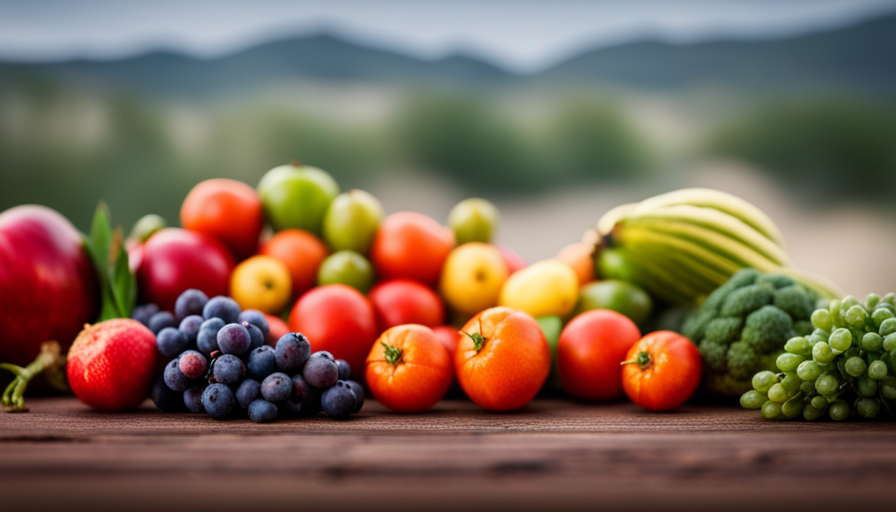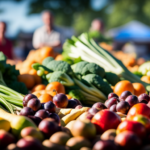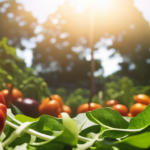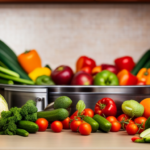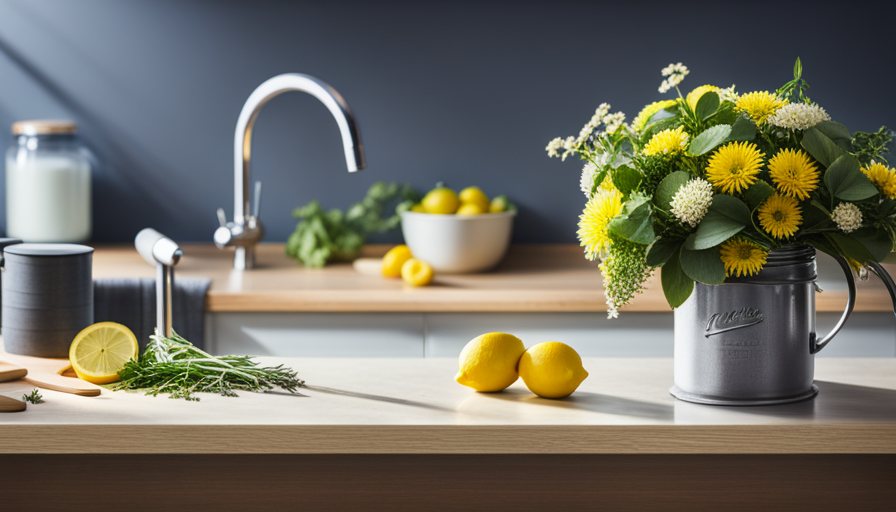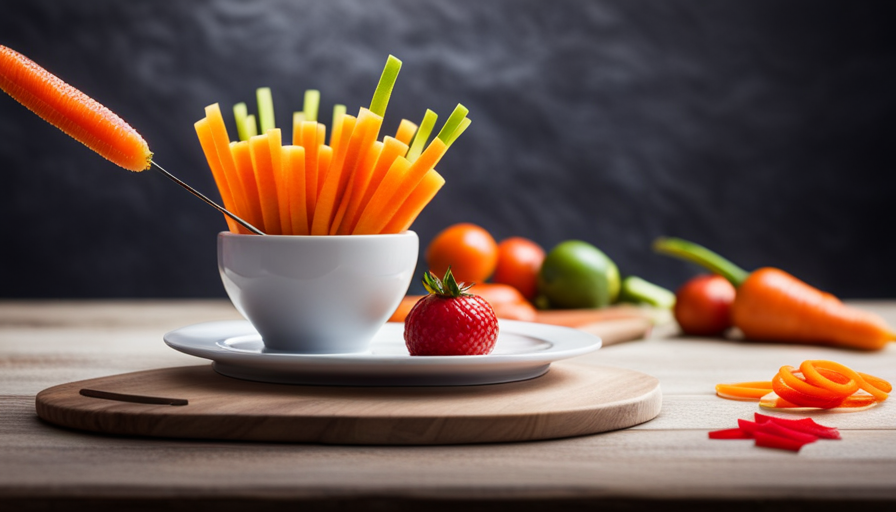Envision immersing yourself in a haven of your own, enveloped by rich hues and captivating scents. A raw food garden represents more than merely an assortment of plants; it stands as an emblem of the bond between the natural world and sustenance. It provides a retreat for nurturing your fresh, nutritious produce, steering you on a path toward supreme health and well-being.
In this article, we will guide you through the art of starting a raw food garden. From choosing the perfect location to harvesting and storing your bountiful yield, we will provide you with the knowledge and tools to create a thriving garden of your own.
You will learn how to select the finest seeds and plants, prepare the soil for optimal growth, and implement organic pest control methods. We will also explore proper watering techniques, delicious raw food recipes, and sustainable practices such as composting.
So, grab your gardening gloves and get ready to embark on this exciting adventure. It’s time to dig deep into the world of raw food gardening and unlock the secrets to a healthier, more vibrant life.
Key Takeaways
- Choose a location with at least six hours of direct sunlight and well-drained soil.
- Select organic or heirloom seeds and consider climate and growing conditions.
- Start seeds indoors for a head start and protection from harsh weather.
- Provide adequate water, sunlight, and nutrients, and use natural fertilizers like compost and manure to improve soil fertility.
Choosing the Right Location for Your Raw Food Garden
When choosing the right location for your raw food garden, it’s crucial to consider factors such as sunlight exposure and soil quality.
Evaluating sunlight availability is essential because most raw food plants require at least six hours of direct sunlight daily. Look for an area in your yard that receives ample sunlight throughout the day, preferably facing south or west. This ensures that your plants will thrive and produce abundant harvests.
Another important factor to consider is soil drainage. Raw food plants need well-drained soil to prevent root rot and other water-related issues. Evaluate the soil in your chosen location by digging a small hole and filling it with water. If the water drains within an hour, that indicates good drainage. However, if it takes longer, you may need to amend the soil by adding organic matter, such as compost or peat moss, to improve drainage.
Additionally, it’s important to avoid areas with heavy foot traffic or close proximity to trees or large shrubs. These can shade your garden or compete for nutrients and water.
By carefully evaluating sunlight availability and considering soil drainage, you’ll be on your way to selecting the perfect location for your raw food garden.
Selecting the Best Seeds and Plants for Your Garden
By carefully handpicking the finest seeds and plants, you’ll be sowing the seeds of a flourishing oasis that celebrates the bountiful wonders of nature.
When it comes to selecting the best seeds for your raw food garden, there are a few tips to keep in mind. First, choose seeds that are labeled as organic or heirloom, as these varieties are more likely to produce nutrient-rich and flavorful crops. Look for seeds that are specifically suited for raw consumption, such as salad greens, herbs, and fruits. Additionally, consider the climate and growing conditions in your area to ensure that the seeds you choose will thrive in your garden.
When it comes to planting techniques, it’s important to follow the instructions provided on the seed packets. Some seeds may need to be soaked or scarified before planting, while others may require a specific depth or spacing. Follow these guidelines to maximize your chances of success.
Consider starting your seeds indoors before transplanting them into your garden, as this can give them a head start and protect them from harsh weather conditions. As your plants grow, be sure to provide them with adequate water, sunlight, and nutrients to support their growth and development.
By carefully selecting the best seeds and plants for your raw food garden and using proper planting techniques, you’ll be well on your way to creating a thriving and abundant oasis of fresh, nutritious produce. Enjoy the journey as you watch your garden flourish and reap the rewards of your efforts.
Preparing the Soil for Optimal Growth
To create an oasis of flourishing plants, it’s crucial to prepare the soil for optimal growth. One of the most important aspects of preparing the soil is improving its fertility. You want to ensure that the soil is rich in nutrients and able to provide the necessary sustenance for your raw food garden. There are several ways to achieve this, and one effective method is to use natural fertilizers.
Natural fertilizers, such as compost and manure, are excellent options for enriching the soil. Compost is made from decomposed organic matter, such as kitchen scraps, yard waste, and leaves. It not only adds nutrients to the soil but also improves its structure and drainage. Manure, on the other hand, is a great source of nitrogen, phosphorus, and potassium. It can be obtained from various animals, such as cows, horses, or chickens.
Incorporating natural fertilizers into the soil is easy. You can spread a layer of compost or manure on top of the soil and gently mix it in. Alternatively, you can create a compost pile or a manure tea to water your plants with. Both methods will gradually improve the fertility of the soil, providing your raw food garden with the nutrients it needs to thrive.
To further enhance the understanding of improving soil fertility and using natural fertilizers, refer to the table below:
| Natural Fertilizers | Benefits |
|---|---|
| Compost | Adds nutrients, improves soil structure |
| Manure | Rich in nitrogen, phosphorus, and potassium |
By incorporating these natural fertilizers into your garden, you can create an environment where your raw food crops will flourish.
Implementing Organic Pest Control Methods
Enhance the health and vitality of your flourishing oasis by implementing effective organic pest control methods. When it comes to maintaining the integrity of your raw food garden, it’s important to prioritize the use of organic pest control techniques.
By avoiding synthetic chemicals and opting for natural remedies, you can protect your plants from pests while preserving the quality of your harvest.
One of the most popular organic pest control methods is companion planting. This involves strategically planting certain crops together to deter pests. For example, marigolds can be planted alongside vegetables to repel insects like aphids and nematodes. Additionally, planting herbs such as basil and mint can help repel pests like mosquitoes and flies.
Another effective organic pest control method is using homemade insecticidal sprays. These sprays can be made by combining ingredients such as garlic, onion, and water. Simply blend the ingredients together, strain the mixture, and spray it onto the affected plants. The strong odor of these natural ingredients repels pests without harming your plants or contaminating your food.
Incorporating physical barriers like row covers or netting can also be an effective way to prevent pests from reaching your plants. These barriers create a physical barrier between your plants and pests, keeping them at bay while allowing sunlight and air to reach your plants.
By implementing these organic pest control methods, you can protect your raw food garden from pests while maintaining the integrity of your harvest. Remember, a healthy garden starts with natural remedies and a little bit of knowledge.
Proper Watering and Irrigation Techniques
Make sure you give your flourishing oasis the nourishment it needs with proper watering and irrigation techniques. Efficient watering techniques are essential for a successful raw food garden. One of the most effective methods is drip irrigation, which offers numerous benefits.
Drip irrigation is a system that delivers water directly to the roots of your plants in a slow and steady manner. This method ensures that water is efficiently utilized, reducing waste and saving you money on your water bill. By supplying water directly to the roots, drip irrigation also minimizes evaporation, preventing water loss and maximizing the hydration of your plants.
Another advantage of drip irrigation is its ability to target specific areas of your garden. With the use of emitters and tubing, you can customize the placement of water sources, ensuring that each plant receives the appropriate amount of water. This precision watering helps to prevent overwatering or underwatering, which can negatively impact the health of your plants.
Drip irrigation also helps to minimize weed growth by delivering water directly to your plants and not the surrounding soil. This reduces the availability of water for weeds, making it more difficult for them to thrive and compete with your crops.
Implementing efficient watering techniques, such as drip irrigation, in your raw food garden is crucial for its success. Not only does it save water and money, but it also ensures that your plants receive the optimal hydration they need to flourish.
Maintaining and Caring for Your Raw Food Garden
Taking care of your flourishing oasis is essential for the success of your bountiful harvest. When it comes to maintaining and caring for your raw food garden, there are a few key techniques to keep in mind.
One important aspect is pruning. Regularly pruning your plants helps promote healthy growth and prevents overcrowding. Start by removing any dead or diseased branches or leaves. This not only improves the overall appearance of your garden but also prevents the spread of diseases. Additionally, pruning encourages the development of more fruits and vegetables, ensuring a plentiful yield.
Another technique to consider is companion planting. This involves planting certain crops together to enhance their growth and deter pests. For example, planting marigolds alongside your vegetables can help repel insects, while basil can improve the flavor and growth of tomatoes. Understanding which plants thrive together and which ones do not can greatly benefit your raw food garden.
Taking proper care of your raw food garden is crucial for a successful harvest. By implementing pruning techniques and companion planting, you can ensure healthy growth, prevent pests, and maximize your yield.
So get out there, put your green thumb to work, and enjoy the fruits of your labor!
Harvesting and Storing Your Fresh Produce
Now that you’ve learned how to effectively maintain and care for your raw food garden, it’s time to reap the rewards of your hard work by harvesting and storing your fresh produce.
Harvesting at the right time ensures that your fruits and vegetables are at their peak flavor and nutritional value. When it comes to storing your bounty, there are several preserving techniques you can employ to enjoy your homegrown goodness all year round.
To make the most of your harvest, consider the following creative food preservation methods:
-
Canning: This tried and true method involves sealing your produce in jars with either a water bath or pressure canner. It’s perfect for preserving jams, pickles, and sauces.
-
Freezing: Freezing is an easy way to preserve fruits, vegetables, and herbs. Simply wash, chop, and place them in airtight containers or freezer bags.
-
Dehydrating: Dehydrating removes moisture from your produce to prevent spoilage. You can use a dehydrator or an oven set at a low temperature to make dried fruits, vegetables, and herbs.
By incorporating these preserving techniques, you can extend the life of your fresh produce and enjoy the flavors of your raw food garden long after the growing season has ended.
Exploring Different Raw Food Recipes and Meal Ideas
Delve into a world of culinary creativity as you uncover a treasure trove of tantalizing recipes and meal ideas that’ll transport your taste buds to new heights.
When it comes to raw food, the possibilities are endless. Start your day off right with a refreshing raw food smoothie. Blend together a mix of fresh fruits like bananas, berries, and pineapple with a handful of leafy greens, such as spinach or kale. Add a splash of almond milk or coconut water for a creamy and nutritious treat that’ll energize you for the day ahead.
For those with a sweet tooth, there are plenty of raw food dessert ideas to satisfy your cravings. Indulge in a decadent raw chocolate mousse made from avocados, raw cacao powder, and a touch of maple syrup for sweetness. Or, whip up a batch of raw energy balls using a combination of dates, nuts, and dried fruits. These bite-sized treats are packed with nutrients and make the perfect guilt-free dessert.
Experiment with different flavors and ingredients to create your own signature raw food recipes. Incorporate fresh herbs and spices to add depth and complexity to your dishes. Don’t be afraid to try new combinations and techniques, as raw food cuisine is all about exploring and pushing the boundaries of traditional cooking.
So, grab your blender and get ready to embark on a culinary adventure with these raw food smoothie recipes and dessert ideas. Your taste buds’ll thank you!
Incorporating Composting and Sustainable Practices
Embrace the opportunity to create a more sustainable lifestyle by incorporating composting and sustainable practices into your daily routine. Not only will this help reduce waste and conserve resources, but it will also provide numerous benefits for your raw food garden.
Here are four ways to incorporate composting and sustainable practices into your gardening:
-
Composting Benefits: Start by creating a compost pile or bin in your garden. Composting allows you to recycle organic waste, such as fruit and vegetable scraps, coffee grounds, and yard trimmings, into nutrient-rich soil. This will not only save you money on fertilizer but will also improve the health and productivity of your garden.
-
Sustainable Gardening Practices: Implement water-saving techniques, such as using drip irrigation or collecting rainwater, to minimize water waste. Choose organic pest control methods, like companion planting or using natural insect repellents, to avoid harmful chemicals. Additionally, practice crop rotation and intercropping to improve soil fertility and reduce the risk of pests and diseases.
-
Use Mulch: Apply a layer of organic mulch, such as straw or wood chips, around your plants. Mulching helps retain moisture in the soil, suppresses weeds, and regulates soil temperature, creating a more favorable environment for your raw food garden.
-
Conservation of Resources: Reduce your environmental impact by using recycled or eco-friendly gardening tools and materials. Opt for biodegradable pots or use recycled containers for planting. When purchasing seeds or plants, choose heirloom or organic varieties to support biodiversity and avoid genetically modified organisms.
By incorporating composting and sustainable practices into your raw food garden, you can create a more environmentally friendly and productive space. Not only will you enjoy the benefits of fresh, nutritious produce, but you’ll also contribute to a healthier planet.
Troubleshooting Common Issues in Your Raw Food Garden
To troubleshoot common issues in your garden, you can identify and address problems such as nutrient deficiencies, pests, or improper watering techniques, which can increase the overall success of your harvest. Did you know that, according to a study, 80% of gardening problems can be resolved by identifying and addressing common issues?
One of the most common issues you might encounter in your raw food garden is pest infestation. Pests like aphids, snails, and caterpillars can wreak havoc on your plants, causing damage and hindering their growth. To tackle this problem, you can try natural remedies such as introducing beneficial insects like ladybugs or using organic insecticidal soaps. Additionally, practicing good garden hygiene by removing weeds and debris can help reduce the likelihood of pest infestation.
Another common issue faced by gardeners is nutrient deficiencies in plants. When plants lack essential nutrients like nitrogen, phosphorus, or potassium, they may exhibit symptoms such as yellowing leaves or stunted growth. To address this, you can use organic fertilizers or compost to enrich the soil and provide plants with the nutrients they need. Regular soil testing can also help you identify specific nutrient deficiencies and allow you to adjust your fertilizer application accordingly.
By being proactive in identifying and addressing common issues like pest infestation and nutrient deficiencies, you can ensure a healthy and thriving raw food garden. Remember to stay observant, take prompt action, and adjust your gardening practices as needed to maintain a bountiful harvest.
Frequently Asked Questions
Can I grow a raw food garden indoors or does it have to be outdoors?
Yes, you can definitely grow a raw food garden indoors! Indoor gardening has its own advantages, while outdoor gardening has its benefits. Growing raw food indoors allows you to have more control over temperature, lighting, and pests. It also extends the growing season, allowing you to enjoy fresh produce all year round. Additionally, indoor gardening reduces the risk of weather-related damage and allows you to optimize limited space. With the right setup and proper care, you can successfully grow a thriving raw food garden indoors.
How long does it typically take for raw food plants to grow and produce harvestable produce?
On average, raw food plants take anywhere from a few weeks to several months to grow and produce harvestable produce. However, you can speed up the growth process by following some best practices.
Ensure that your plants get plenty of sunlight, as this is crucial for their growth. Additionally, provide them with nutrient-rich soil and water them regularly. Pruning and fertilizing can also help increase growth speed.
Are there any specific types of seeds or plants that are recommended for beginners in raw food gardening?
For beginners in raw food gardening, there are a few types of seeds that are recommended. Easy-to-grow vegetables like lettuce, radishes, and spinach are great choices to start with. These seeds germinate quickly and require minimal care.
Once planted, make sure to provide them with enough sunlight, water, and nutrients. Regularly check for pests and diseases, and take appropriate measures to protect your plants. With proper care, you’ll soon be enjoying your homegrown raw food harvest.
What are some common pests that I may encounter in my raw food garden and how can I prevent or control them organically?
In your raw food garden, you may encounter common pests like aphids, snails, and caterpillars. To prevent or control them organically, there are effective pest control methods and natural remedies you can use.
For aphids, try spraying a solution of water and dish soap on the affected plants.
To keep snails away, create barriers using crushed eggshells or coffee grounds.
For caterpillars, introduce beneficial insects like ladybugs or use Bt (Bacillus thuringiensis).
These methods will help protect your raw food garden naturally.
Can I use tap water for watering my raw food garden or is it better to use filtered or rainwater?
Using tap water for your raw food garden is convenient and readily available, but it may have some drawbacks. Tap water often contains chlorine and other chemicals that can be harmful to your plants.
Rainwater, on the other hand, is natural and free from these contaminants. However, it may not always be reliable or accessible.
Another option is using filtered water, which removes impurities but can be more expensive. Consider your options and choose what works best for your garden’s health and your convenience.
Can the Ingredients from a Raw Food Garden Be Used in a Raw Food Kitchen?
Yes, the ingredients from a raw food garden can certainly be used in preparing a raw food kitchen. Fresh fruits, vegetables, and herbs harvested from the garden can be incorporated into delicious raw food dishes, ensuring maximum nutrient retention and flavor. It’s a great way to create healthy and vibrant meals.
Conclusion
In conclusion, starting a raw food garden can be a rewarding and fulfilling experience. By following the right steps and implementing sustainable practices, you can enjoy a bountiful harvest of fresh and healthy produce.
Imagine waking up each morning and picking your own ripe tomatoes for a delicious salad or harvesting fresh herbs to add flavor to your meals. The satisfaction of knowing that you’re nourishing your body with organic, homegrown food is truly priceless.
So why not give it a try and create your own little piece of paradise right in your backyard?


